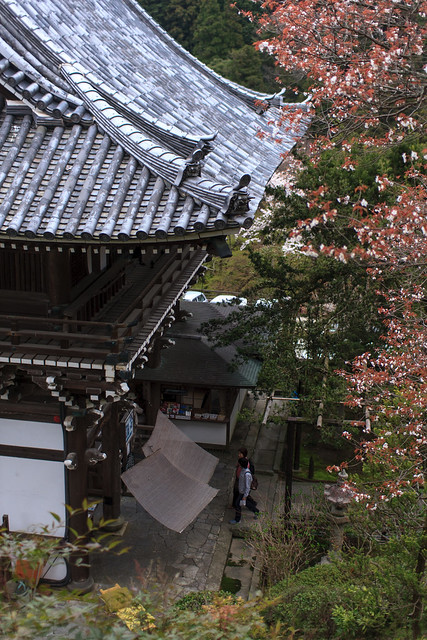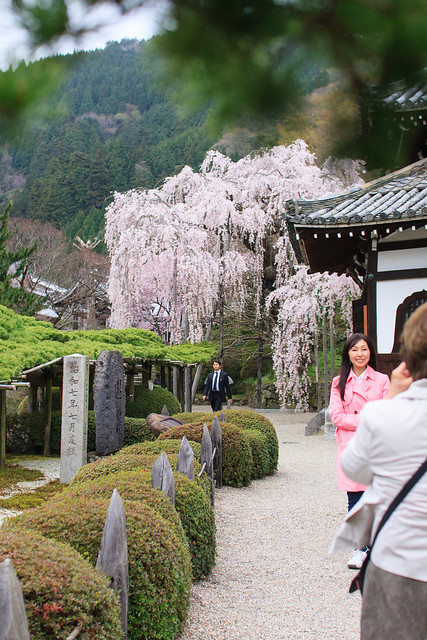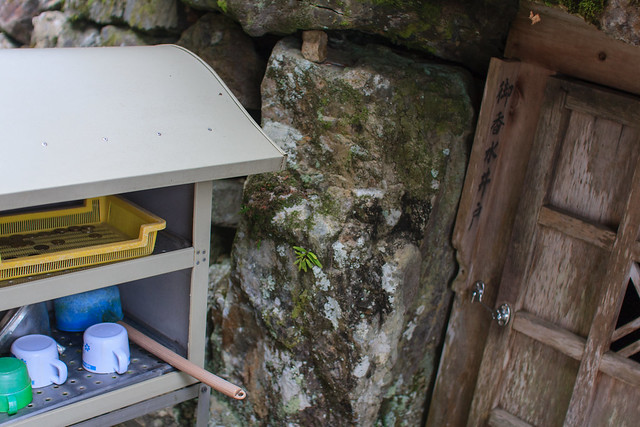 |
| The Main Gate |
Place Name: Yoshimine-dera 善峯寺
Type: Temple 寺
Location: Nishikyo Ward, Kyoto Prefecture, JAPAN
Latitude: 34.938172
Longitude: 135.644203
Date of Visit: April 16, 2012
Access: Hankyu Bus #66 from Hankyu Higashi Muko station or JR Muko-cho station
Fee: Adults ¥500 / Parking ¥500
Hours: 8:00~17:00
Every temple in the Saikoku 33 pilgrimage is a special place. The surrounding landscape, as I have mentioned before, is equally unique. The monks who nearly 1,000 years ago that established this temple also must have found the landscape intriguing enough to warrant such an outlay of labor, material and treasure to build these amazing complexes. Yoshimine-dera is located up a steep, tight valley west of downtown Kyoto. It’s on the opposite side of the Kyoto basin of the much more popular and well-known Kyomizu-dera. While being listed on some of the Kyoto city tourism websites in English this was my first time hearing of it, and that is only thanks to its inclusion as the 20th temple in the Saikoku 33 temple pilgrimage.
The terraced garden
Driving up to the temple requires trust of your maps and car navi. Kyoto, in general, is much tougher to drive in than any other area in Kansai. Small streets that really should be alleys and the local drivers who take them at breakneck speeds. After passing under the currently under construction Kyoto Jyukan Expressway the temple road (京都府道208号) really begins to pick up elevation. Along the way are signs advertising bamboo shoots (takenoko 竹の子) that are harvested from the surrounding forests. The neighborhoods on the foot of Mt. Nishiyama are locally famous for this spring vegetable. We picked up a decently sized bag for ¥1,000. The road’s steep final accent leads to two parking lots. The older lower lot has a good set of switchbacks to get to the temple, or you could skip them and use the upper lot.
 |
| Looking down on the Yuryu no Matsu |
The temple complex takes 30-40 minutes to walk through and covers 30,000 tsubo or about 9 KM2--if I converted that correctly. The two guardian king statues that are placed on either side of the main gate were made by Unkei a Kamakura era sculptor. His painterly statues are considered some of the best in Japanese art and include many national treasures some of which are kept in the treasure hall in Kofuku-ji in Nara. From the main gate where the entrance fee is taken it’s a short walk to the main temple and where you get your scroll signed as we did. The main temple building is majestic and beautiful, but is overshadowed by the surrounding buildings and gardens.
Directly to the right of the main temple a door is built into the rock lined retaining wall. Behind that door is a natural well. The water, known as Okozui (お香水), is used in offerings to Buddha and believed to extend ones life. Next to the door is a tray for monetary offerings, a selection of cups, funnels and some ladles. Nearby, hidden under the temple stairs were a few 2-liter plastic bottles, the stash of temple visitor who left them there to fill up after they walked the grounds. The water was cool and had a soft feel in the mouth. It is rare that one can drink water that is unprocessed, un-bottled, untouched by anything other than nature. Drinking this well water alone makes the trip to Yoshimine-dera worthwhile.
Making prayers and the water here is also said to help cure neuralgia and chronic lower back pain. In fact, the temple used to offer a prayer and bath service once a month to the faithful. Sadly the service has been cancelled.
Yuryu no Matsu
There are many other natural treasures found in the temple grounds. Sakura, ajisai, and momiji among other flowers are all cultivated on the grounds and attract viewers when they are in bloom. The most famous and greatest natural attraction is the 600 year old Japanese white pine, Yuryu no Matsu (遊龍の松). This tree spreads out in a flat 90-degree bend over along a terrace above the main temple. It is like a giant human sized bonsai tree. The age of this magnificent tree can be seen in its twisted knotted wood. Just like the bristlecone pines of California’s eastern Sierra, the Yuryu no Matsu has a sense of wisdom and age that is instantly apparent from first sight.
 |
| Yuyru no Matsu and a Weeping Sakura |
Other gardens, temple buildings, small shrines, pagodas, and a toilet with an amazing view of downtown Kyoto, including the oft-maligned Kyoto Tower, are all here for exploration. Every one of the Saikoku 33 temples is an extraordinary place, but some are so amazing that they should be visited whether you are on the pilgrimage or not. Yoshimine-dera is one of those temples.
 |
| Looking towards the main gate |



2 comments:
Amazing photos as always. I love the trees.
Beautiful !
The weeping Cherry trees are lovely.
I wish could see the Japanese White Pine tree better. From your photo it looks fabulous.
Sorry but I would be the one who used the upper parking lot
Thank you for the photo tour !
How many of the 33 temples have you visited ?
cheers, parsnip
Post a Comment